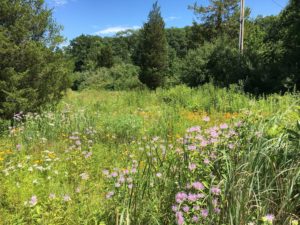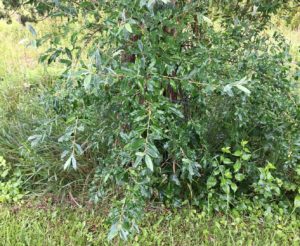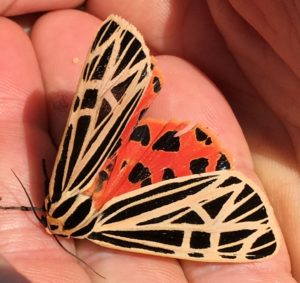Hello fellow readers, A walk in the meadow with my friend and go-to mystery solver of all things in nature is always a treat. While Dennis Briede’s day responsibility is Stewardship Manager for The Land Conservancy of New Jersey (http://tlc-nj.org/), his true passion is living among nature. Even his vegetable garden is filled with pollinator-attracting plants such as Echinacea and verbena specifically procured and planted to nurture nature.
His meadows where he lives in Blairstown NJ are exceptionally lush this year due to the plentiful rains. As we walked through the trails, he pointed out common buckthorn (Rhamnus athartica) that he cut down. First one he saw around here. They were brought from Europe in the mid-1800s. It was once sold in nurseries as a hedge plant before taking over New England, then became banned for sale in the 1930’s.
Most have heard about the dreaded multiflora rose (Rosa multiflora) and autumn olive (Elaeagnus umbellate). Both were intentionally brought here from Asia in the 1800s. The multiflora rose served as an understock in propagation for ornamental roses. No surprise, as they are tough and disease resistant with white prolific blooms most of the summer. In the 1930s, the U.S. Soil Conservation Service promoted multiflora rose for erosion control and as a 15-foot “living fence” for livestock.
Autumn olive was introduced as an ornamental plant ideal for windbreaks. A deciduous shrub, about 20 feet, with narrow, dull green leaves atop silvery or brown rusty scales below. In the 1950’s it was endorsed as a great solution for creating wildlife habitats in areas disturbed by development. Birds and other wildlife who love the berries helped proliferate the spread of the now dreaded invasive species that shades and squelches native species. Isn’t it ironic how what is once adored can become despised?
Among Dennis’s meadow are thriving natives such as goldenrod and monarda. Plus, the narrow-leaved mountain mint (Pycnanthemum tenuifolium) and Virginia mountain mint (Pycnanthemum virginianum) create clouds of white flowers all over his meadow; a lure for pollinators from July to September when in bloom.
Dennis’s enthusiasm over three juniper hairstreaks (Callophrys gryneus) was contagious. I had to look closely to appreciate the ornate green, taupe with white streak details of this rare to see petite beauty with only an inch wingspan. The next day he recorded 16 juniper hairstreaks in a two-hour butterfly survey during which he found 20 species of the 70 he’s had on his property to date. “A very productive day.”
A virgin tiger moth, Grammia virgo, was my favorite marvel during our walk. When her wings are closed, she’s a beautiful light beige with black zebra stripes. When she opens her two-inch wingspan, red with black polka dots reveals. Quite a fashion statement that will hopefully never go out of style. Garden Dilemmas? AskMaryStone@gmail.com and your favorite Podcast App
Dennis has a gift of sharing the accounts of critter visits…
“Remember the bluebird that tapped on the glass for mealworm handouts?” he began his story. “This year, I placed the bowl high on the deck rail away from the slider. Friends visiting marveled at the bluebirds when a bear I named Buddy came by. Only a few feet from Buddy a bobcat meandered. The biggest one I’ve ever seen! Not far behind a doe grazing. It was amazing to see all of them so close together!” Dennis’s animated excitement in full gear.
“The bobcat tucked into the brush, so I…”
Dennis paused to demonstrate the sound of a rabbit in distress by bringing his lips to his arm and blowing air. I recall as a child a similar antic but didn’t know it was a call to the wild (smile).
“The bobcat came back to investigate. It was amazing!”
As we walked along a path towards the back of the property, Dennis pointed out the large paw-shaped worn turf made by male bears making their mark in the pursuit of Buddy, who he thought was a male until she showed up with two cubs a few years back.
“A female bear is either pregnant or taking care of cubs,” Dennis explained. “I’ve seen Buddy rubbing noses with two different males. She sure gets around,” he chuckled. “For sure, she’ll have a cub or two come spring.”
Column Updated 8/1/22







